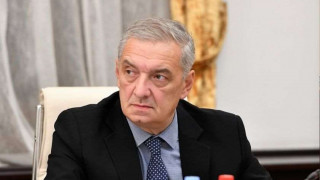-
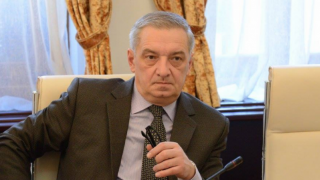
The ministers’ salaries have decreased significantly as compared to 2012. The total administrative expenses to GDP ratio has decreased
Giorgi Volski’s statement is TRUE.
TrueThe statement is accurate and nothing is missingVS
-
Administrative expenses have increased by GEL 685 million since your coming to power. The amount of employees was 101,000 and in 2018 it is 116,000
Nika Melia’s statement is MOSTLY FALSE.
Mostly FalseIn the statement is the elements of the truth, but the important facts that could have made other impressions23/03/2019ნახვა 4728
Resume: In order to analyse the trend of changes in administrative expenses over time, it is appropriate to use relative figures vis-à-vis the gross domestic product (GDP) or budget assignments instead of using nominal figures. A comparison of the nominal figures for expenses in a seven-year period is incorrect because, on the one hand, the nominal figures for budget revenues and expenditures increase in this period and, on the other hand, the inflation factor is not excluded. Therefore, Giorgi Volski’s approach when he speaks about relative figures is correct whilst Nika Melia’s comparison of nominal figures is incorrect.
The consolidated budget’s administrative expenses to GDP ratio has decreased in 2019 as compared to 2012. In particular, the administrative expenses to GDP ratio dropped from 9.6% to 7.4% whilst the administrative expenses to current expenditures ratio dropped from 38.5% to 32.7%. In addition, the share of funds allocated for labour remuneration decreased both in the consolidated budget and in the state budget in the same period. In regard to the salaries of the ministers specifically, the average monthly salary for ministers in 2011-2012 was GEL 7,080 which has decreased since 2014 with a minister’s salary currently at GEL 6,250. Of note is that since 2018, there has been a law banning bonuses and salary supplements for ministers as well as for other public figures and those holding a political office and imposing a ceiling for labour remuneration.
In 2012, the number of employees working in state budget spending institutions was 103,000 whilst this number was 113,600 in 2018. In accordance with the 2019 state budget, the number of these aforementioned employees is 112,100. Therefore, the number of people employed in the public sector has increased as compared to 2012.
Analysis
During a TV debate on air on Rustavi 2, MPs Giorgi Volski and Nika Melia discussed administrative expenses. As stated by Mr Volski: “The salaries of the ministers have significantly decreased as compared to 2012. The total administrative expenses to GDP ratio has decreased.”
In response to the aforementioned statement, United National Movement parliamentary faction member, Nika Melia, stated: “Administrative expenses have increased by GEL 685 million since your coming to power. The number of employees under the previous government was 101,000 whilst in 2018 it is 116,000.” Given the figure of 116,000 in Mr Melia’s statement, this refers to the number of employees working in state budget spending institutions.
A budget’s administrative expenses are the sum of the budget funds allocated for labour remuneration and the purchase of goods and services. However, the goods and services component also consolidates certain expenses in order to ensure defence and order (police) which objectively should not be considered as administrative expenses.
In order to analyse the trend of changes in administrative expenses over the years, it is appropriate to compare relative figures instead of analysing nominal indicators. The reason for this is that the nominal figures of the state budget amount increase over the years and, therefore, the nominal figures for administrative expenses increase as well. The second reason behind the growth in administrative expenses is inflation. In particular, given the annual increase in the level of prices, less money was needed to purchase the same amount of goods and services in 2012 as compared to the present day. The labour remuneration of public servants cannot be kept unchanged and together with changes in macroeconomic parameters, a salary increase is an objective necessity and this is something which also increases the nominal volume of administrative expenses.
The consolidated budget includes the consolidated figures of the state budget as well as the budgets of autonomous republics and self-governing bodies. The administrative expenses of the consolidated budget are the expenses for labour remuneration and purchasing goods and services. In the 2019 consolidated budget, the planned amount of administrative expenses is GEL 3,334 million (of this amount, labour remuneration is GEL 1,762 million and the purchase of goods and services is GEL 1,572 million) which constitutes 7.4% of the estimated GDP and 32.7% of the budget’s current expenditures in the same year. The nominal amount of administrative expenses in 2012 was GEL 2,500.3 million which was 9.6% of the GDP and 38.5% of current expenditures. Therefore, the administrative expenses to consolidated budget ratio decreased in the period of 2012-2019. In particular, the administrative expenses to GDP ratio decreased by 2.2 percentage points and the administrative expenses to current expenditures ratio dropped by 5.8 percentage points, including a 0.7 of a percentage point decrease in the labour remuneration to GDP ratio and a 1.5 percentage point decrease in the goods and services to GDP ratio.
Graph 1: Consolidated Budget’s Administrative Expenses (GEL Million, %)
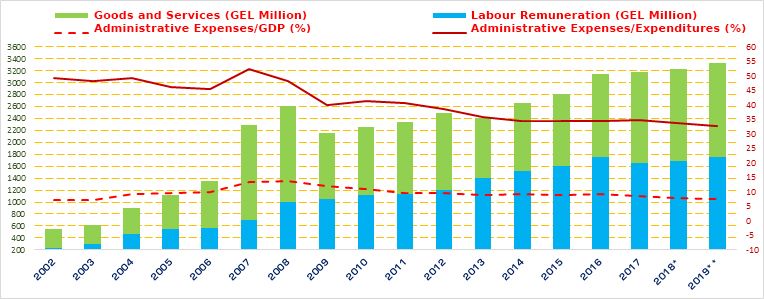
Source: Ministry of Finance of Georgia
The state budget’s administrative expenses include the bureaucratic expenses of the state government bodies (spending institutions). Similar to the consolidated budget, the relative figures of a state budget’s administrative expenses have a tendency of decrease. In accordance with the 2019 plan, the nominal amount of administrative expenses is GEL 2,688.8 million which constitutes 6.0% of the estimated GDP. The same figure in 2012 was GEL 2,110.4 million; that is, 8.1% of the GDP. Therefore, the state budget’s administrative expenses to GDP ratio decreased by 2.1 percentage points in 2012-2019. In addition, the state budget labour remuneration to GDP ratio decreased from 4.0% to 3.3% whilst the goods and services to GDP ratio decreased from 4.1% to 2.7% in the same period.
Graph 2: State Budget’s Administrative Expenses (GEL Million, %)
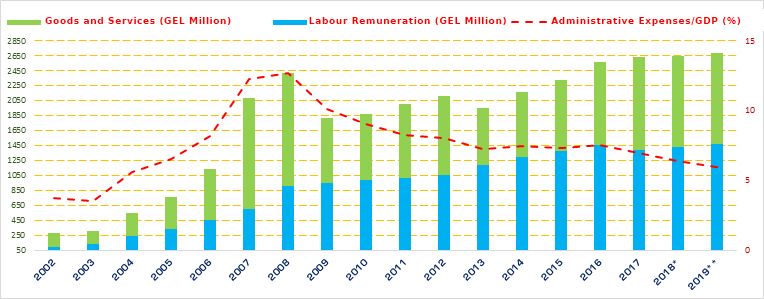
Source: Ministry of Finance of Georgia
As illustrated by the graphs, the decrease in the consolidated budget’s administrative expenses is mostly related to cutting administrative expenses in the state budget because the administrative expenses of self-governing bodies to GDP ratio decreased by only 0.1 of a percentage point in 2012-2019 whilst the administrative expenses of the state budget to GDP ratio decreased by 2.1 percentage points. An important decrease in the relative figures of administrative expenses in the state budget started in 2017 when the administrative expenses to state budget ratio decreased by 0.8 of a percentage point followed by 0.6 and 0.4 of a percentage point decreases, respectively. In the same period, the respective indicators for self-governing bodies remained the same.
Prior to 2018, the labour remuneration for ministers included a salary, a supplement and a bonus. Labour remuneration for minsters includes only a salary beginning in 2018. Since 2018, salary supplements and bonuses have been legally banned for government officials and for those holding a political office. Therefore, a minister gets only a salary because he is a government official.
Beginning in November 2007, labour remuneration for minsters increased to GEL 3,540. Ministers received this amount of salary until 2018. In the same period, ministers were able to receive bonuses and supplements which had no ceiling prior to 2013. In 2011-2012, a minister’s labour remuneration in the form of bonuses and supplements was on average equal to the salary. In the aforementioned period, ministers received bonuses and supplements equal to their salary. Consequently, the average monthly labour remuneration for a minister in 2011-2012 (salary, bonus and supplement) amounted to GEL 7,080. However, the amount of labour remuneration received in the form of bonuses and supplements exceeded the salary in a number of cases. In March 2013, a permanent monthly supplement for ministers of GEL 4,335 was introduced in accordance with a decree of the Prime Minister of Georgia.
Therefore, the monthly labour remuneration for ministers was GEL 7,875 (GEL 3,540 salary and GEL 4,335 supplement). The amount of the aforementioned supplement decreased to GEL 2,710 in 2014. As a result, ministers received GEL 6,250 as their labour remuneration (GEL 3,540 salary and GEL 2,710 supplement) in 2014-2017.
Graph 3: Labour Remuneration of the Georgian Ministers (GEL)
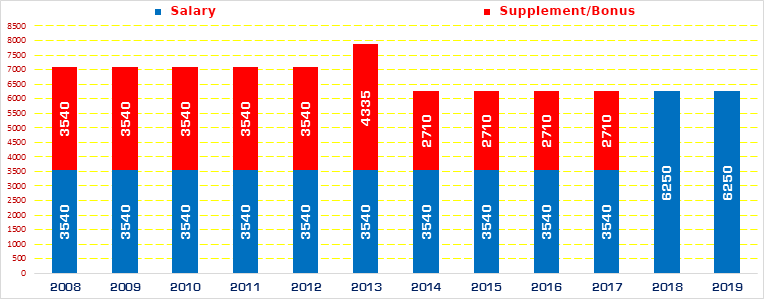
Source: Information received from ministries, Georgia’s Legislative Herald
As illustrated by the graph, the monthly labour remuneration for Georgian ministers in 2014-2019 is GEL 6,250 which is less as compared to their labour remuneration in 2011-2013.
In regard to the number of employees, the number of employees working in state budget spending institutions was 103,000 in 2012 whilst this number is 112,100 according to the plan for the 2019 state budget. In the aforementioned period, the number of employees increased by 9,100 according to state budget figures.
Graph 4: Number of Employees in State Budget Spending Institutions
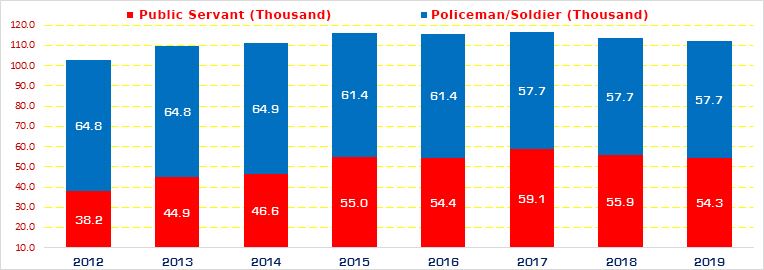
Source: State budget data
Of note is that the aforementioned growth in the number of employees is not caused by the growth in employees in the central offices of the ministries but is instead related to the LEPLs which were legally created within the same period.
Similar News
-

“The twenty-two-percent growth of the USD-denominated econom...
Mostly TrueThe application is accurate, but requires additional information and/or definition -

“A total of 303 thousand people work for salaries up to EUR ...
Mostly TrueThe application is accurate, but requires additional information and/or definition -

“The price of fuel is GEL 1.65 when arriving at the border b...
TrueThe statement is accurate and nothing is missing
Most read
-

“The budget deficit has reduced from 9.3
Mostly TrueThe application is accurate, but requires additional information and/or definition -

“The real purchasing power of pensions h
LieThe statement is inaccurate and the assertion in it is absurd -

“During the Georgian Dream’s governance,
FalseThe statement is inaccurate -

“Georgia experienced an inflation rate o
Half TrueThe statement is partly accurate, but the details are missing or some of the issues are without context -

FactCheck Georgia participates in creati
FactCheck NewspaperFactCheck Newspaper







